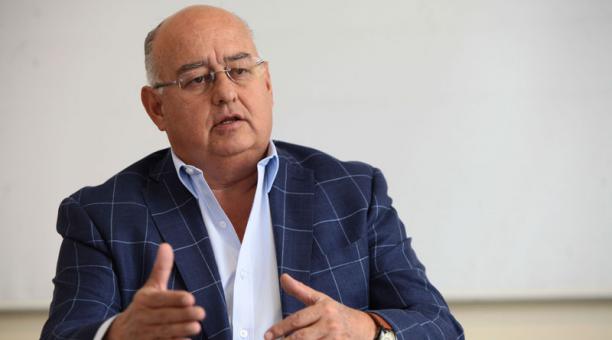Finance Minister Mauricio Pozo announced on Thursday that the country is negotiating the support of multilateral organizations to issue a bond in the international markets to support the private productive sector.
Ecuador is in negotiations to issue an international market bond that will allow it to raise around $3 billion to support the recovery of the private sector. Regarding the bond, the Minister was very specific in saying that the bond “is not sovereign debt.”
The resources would be channeled as credits through the Ecuadorian financial system and public banks, according to statements by Minister Pozo.
The role of multilateral credit organizations, such as the Development Bank of Latin America (CAF), would be to act as guarantors of the country for the issuance of the bond. It would not be the first time that Ecuador has sought to issue this type of bond. In January 2020, the country issued a social bond for $400 million with a 15-year term, with a guarantee of $300 million from the Inter-American Development Bank (IDB).
The resources obtained with the issuance of the so-called social bond would be to finance credits to activate the Government’s social interest housing program.
Reactívate Ecuador not working
The minister acknowledged that the Reactívate Ecuador program, whose objective was to especially support small and medium-sized companies after the economic blow suffered by the COVID-19 pandemic, has not worked as expected.
There was an exaggerated expectation that the program would provide $1.15 billion in loans to companies, but Pozo clarified that only about $500 million of the full amount was to support businesses.
The rest of the money, the Pozo explained, was part of a broader economic revival program.
The Reactívate Ecuador program in fact has four components, according to the Finance Ministry:
- $300 million provided by the International Financing Corporation of the United States, is to be used to fund loans through the private banks of Ecuador.
- $260 million from the World Bank, was provided to the National Finance Corporation (CFN) for second-tier loans, of which $120 million have already been delivered but not yet placed on the market, and $140 million will be disbursed when CFN places the first section.
- $93.8 million from the Inter-American Development Bank (IDB) has been directed toward the National Corporation for Popular and Solidarity Finance.
- $150 million for this year and $300 million for 2021, was directly allocated for Reactívate Ecuador credit, channeled through Banco del Pacífico.
Minister Pozo admits that all these credit lines have been approved, but that the loans are not being disbursed.
Reactívate Ecuador “has not worked well because not all the planned money has arrived, and because the conditions are not attractive for the financial system. We are about to announce a second part of the program, under another more appropriate mechanism,” he said.
The credits would be directed especially to small and medium-sized companies and to sensitive sectors of the economy, such as commerce, entertainment activities (which include tourism) and agribusiness.
The other big problem is that there is liquidity, but due to political and economic uncertainty, companies are not demanding loans and “the conditions must be created to reactivate the demand for credit.”
“I am optimistic”
In the midst of the crisis in Ecuador, Minister Pozo gave signs of optimism. He also announced last Thursday that the “goal review” with the International Monetary Fund (IMF) was successful and that the IMF technical team felt Ecuador had met its requirements for further disbursement of the loans agreed to in October.
Ecuador will have access to financing of approximately $2 billion from the IMF once the executive board of the organization completes the review of the economic program.
In a press release on Tuesday,the UMF reported that “the agency’s technical staff and Ecuadorian authorities reached an agreement at the technical level, on the first review of the 27-month SAF program.”
According to the IMF, between October 28th and November 20th, there were virtual meetings to discuss the progress of the reforms and the policy plans of the authorities in response to the impact of COVID-19 and the price of oil.
Ceyda Oner, who led the meetings of the IMF mission, said the agreement is subject to the approval of the agency’s management and the board of directors and the implementation of actions.
The IMF projects that the economy will contract 9.5% in 2020 instead of the 11% initially projected.
Ceyda said the fiscal balance goal was exceeded by a wide margin, with 63,764 additional low-income families having been incorporated into social assistance programs.
“In the remaining months of the current administration, the authorities plan to implement key reforms to strengthen Ecuador’s institutions and legal frameworks. In the short term, they are actively exploring amendments to its penal code to criminalize corruption and align its anti-corruption framework with the best international practices,” she said.
She also highlighted that Ecuador is working on modifications to the Organic Monetary and Financial Code—in order to strengthen the foundations of the dollarization regime—and is also operationalizing the Organic Code of Planning and Public Finance, that will improve the audit capabilities of the Central Bank of Ecuador.
“I am optimistic that we will be able to close the year as it should be,” said Pozo, pointing to some indicators that show that Ecuador’s economy is recovering, such as the increase in tax collection between October and September.
Minister Pozo believes that the country could grow close to 3% in 2021, although the ideal would be growth rates of 4% in the coming years to repair the damage caused by the crisis.


0 Comments